This past Whitsun weekend I was in Budapest. Even though it’s just a 2 ½ hour train ride from Vienna (where I live) I hadn’t been to this fabulous capital city of Hungary since October 2008, so a re-visit was overdue. I had only a bit over 48 hours there but used the time well. Here’s a short report with some selected photos:
In terms of dark tourism my first priority was a sight that I learned about only after my previous visit to Budapest. That’s the Hospital in the Rock and Nuclear Bunker. Here’s a photo of the entrance as it looks now:

There were already natural caverns inside this large rocky hill which were later expanded. Most importantly, the underground tunnel system was converted into a secret hospital during WWII. During the Siege of Budapest between December 1944 and February 1945, the hospital became increasingly overcrowded and conditions deteriorated further when supplies of water and meds ran out. In fact Castle Hill – and the hospital inside it – were the last stronghold of defence against the Soviets. This site also played a role in the Hungarian Uprising of 1956, which, again, was brutally crushed by the Soviets. Later, during the Cold War, the hospital was revived and expanded into a nuclear shelter.
Today’s museum tries to recreate scenes from those periods, with an emphasis on WWII. On the one-hour guided tour you see lots of medical equipment and dozens of mannequins people the place as patients, doctors and guards. Normally I find such dummies a bit cheesy, but I have to admit that these were so varied and often quite expressive, that they managed to convince more. Unfortunately there was a strict no-photography rule in place, so I can’t offer any images from the inside.
.
Another priority of mine on this trip was a pilgrimage to the infamous Plot 301 of the New Municipal Cemetery on the very outskirts of Budapest at the end of a long tram line that takes more than half an hour to get there.
It’s an enormous cemetery, one of the largest in Europe. And while the graves in the sections nearer the main entrance are fairly tidy and there was lots of activity (mainly mourning relatives taking flowers to loved ones’ graves) in those parts, a bit further in, the atmosphere changed substantially and there were more and more atmospherically overgrown graves – as for instance in this photo:

In terms of sepulchral artwork, this cemetery cannot compete with the marvellous Kerepesi Cemetery closer to the city centre, but a few fine works of stonemasonry could be spotted. Here’s an example:
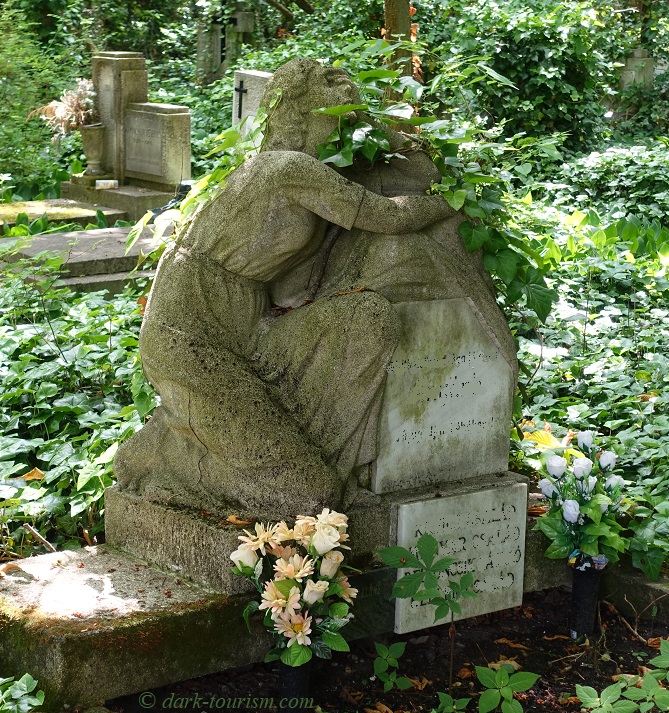
The main point of interest from a dark-tourism perspective, however, is section/plot 301 (‘Parzella 301’ in Hungarian). That is because it was here, in the furthest north-eastern corner of the area, that Imre Nagy was buried, the Prime Minister of Hungary and leader of reform and eventually revolt in 1956 against Soviet domination. After the brutal crushing of the uprising, Nagy was arrested and later subjected to a staged “trial” in which he was sentenced to death in 1958. After his execution, he was buried in this remote spot alongside dozens of co-victims in unmarked graves. When Nagy’s body was exhumed at the end of the communist period in 1989 he was found lying face-down with his hands tied with barbed wire. He was subsequently given a grand reburial as he was rehabilitated. The plot was then converted into the large memorial site it is now
The site was not easy to get to on foot (most visitors come by car), and I found out the hard way that going the straightest route that the map suggests does not work, because the paths closer to the spot get more and more overgrown and eventually became completely covered in undergrowth and were impassable. So I had to retrace my steps and find a different approach. This I found along a tarmacked road further south that led into an approach road north that ends at a car park by the site. The memorial consists of a field of wooden stelae, plaques with lists of names, a symbolic crematorium, a memorial hall, and several individual graves.
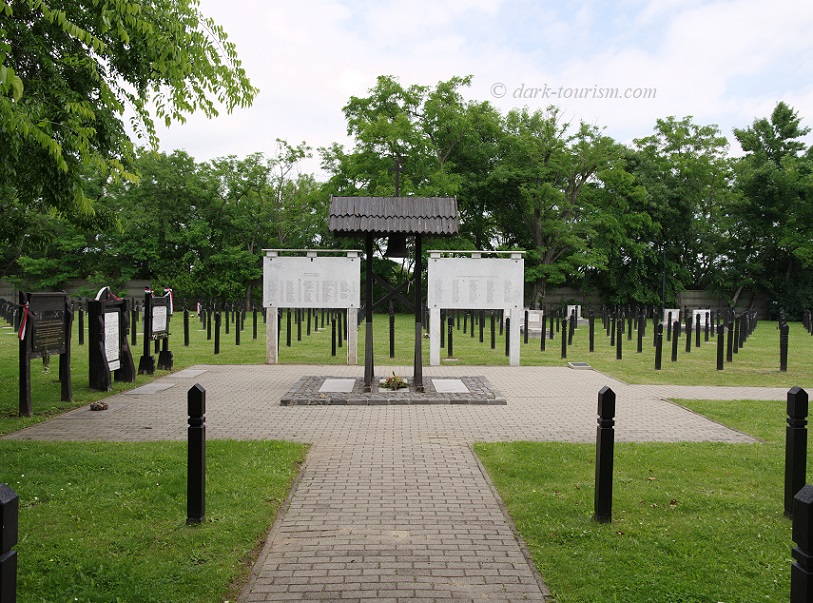
After some looking around I eventually managed to track down the final (?) resting place of Imre Nagy. Pilgrimage goal accomplished!

On a nearby gravestone I found an example of accidental aesthetics of decay, namely these beautifully withered flowers that almost look like the work of an artist too:

.
Adjacent to this cemetery is also a Jewish cemetery, in fact one of the largest in Europe too. It is said to be in a badly overgrown state though some clearing work has been done (as I learned from a poster in the former Jewish quarter in the city centre). Unfortunately, however, there was no access. The gate was padlocked and there was nobody about (and climbing over the fence/wall would have required a ladder). So I could only peek through the gate. Just behind the main gate to the cemetery stands this grand white synagogue:
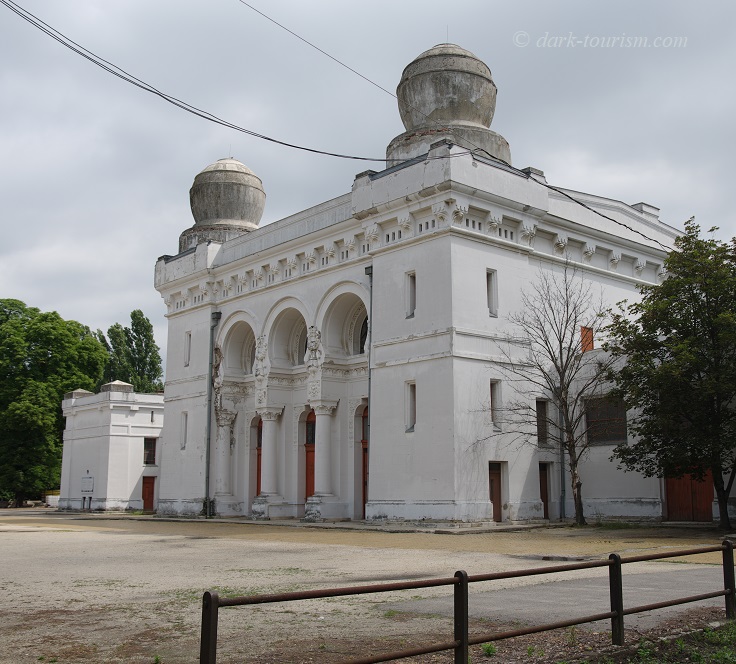
.
The once large Jewish population of Budapest was tragically one of the last to be virtually eradicated in the Holocaust, as late as from March 1944 when Germany occupied Hungary. Yet the largest synagogue in Europe (along with several smaller ones) survived and is again amongst the city’s premier sights. It’s the Dohany Street Great Synagogue, and as my hotel was just round the corner I went back to take in this exceptionally beautiful building. Here’s a current photo:

.
My third main priority in terms of dark tourism on this trip was to finally go and see the Semmelweis Museum. This is a medical museum set up within the former home of Ignaz Semmelweis, the pioneer in obstetrical medicine now credited with having discovered the cause of, and protection against, so-called childbed fever, which back at the time in the mid-19th century cost many a mother’s life shortly after childbirth. He discovered that it was an infectious disease that could be prevented by doctors and midwives properly washing their hands with disinfectant. Yet he was largely ridiculed and ignored at the time and died a broken man. Only later, after Louis Pasteur confirmed the approach by Semmelweis, was he posthumously rehabilitated and properly credited for his discovery.
At the Semmelweis Museum you can not only see his study and living room, various publications and references to films about Semmelweis, but it’s also a proper medical museum, ranging from antiquity (e.g. medical practices and beliefs in Ancient Egypt and Rome) to the 20th century, though not quite the contemporary age – the newest exhibit I spotted was from the 1960s.
Here’s a shot of the interior (yes, unlike at many other medical museums, photography was not only not prohibited but even encouraged by the museum warden), showing two dentist chairs from different periods in the foreground:

The white chair on the left looks not much different to present-day equivalents, whereas the darker one on the right shows its age by the presence of that pedal-and-wheel mechanical drill contraption.
And if you’re a bit wussy when it comes to dentistry, or perhaps icky medical exhibits in general, then I would advise you to either stop reading now or to scroll very quickly past the next three images coming up.
The first of the icky images isn’t so drastic yet. It’s only a replica, namely of the skull of Semmelweis, showing signs of it having been sawn open after he was exhumed and his body underwent a post-mortem examination.

In the section about ancient Egyptian medicine there are several mummified items, including a raven mummy, a blackened woman’s foot and, most drastic of all, this whole mummified human head:

There were also several anatomical wax models (‘moulages’) on display at the museum, ranging from individual human organs to this extraordinary full-body woman with an opened abdomen and chest:
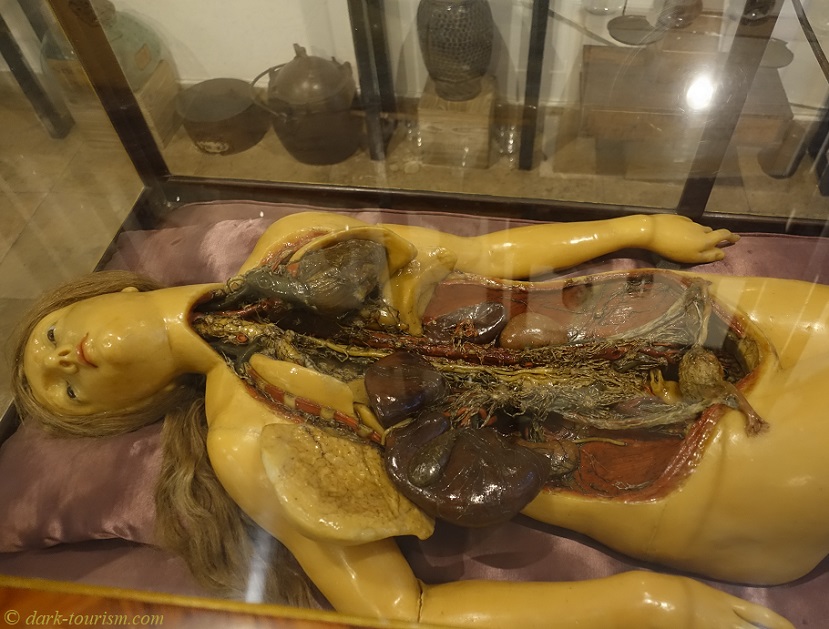
This reminded me very much of a similar exhibit of a cut-open-woman wax model that you can see at the Josephinum Medical Museum in Vienna.
.
But enough of medical gore, and back to architectural beauty. Probably the top place in that category in Budapest has to be the grand neo-Gothic parliament building, seen here from across the River Danube:

In the sense that this is the place from where the right-wing government of controversial prime minister Viktor Orbán wields its power, some may consider this parliament building a dark place too. But just behind it, on the large square in front of the entrance to the parliament, I found a proper dark-tourism attraction that I hadn’t even known existed (an oversight on my part, I know!). I just stumbled upon it by chance.
It’s the official memorial to the 1956 Hungarian Uprising. Here’s a photo of the entrance, where the the figure 1956 cut into the metal side walls is projected on to the ground by sunlight (in a similar fashion utilized at the well-known House of Terror on Andrássy Boulevard):

Inside is a small but poignant exhibition, combining original artefacts with video and photo projections, a memorial hall with victims’ names as well as interactive touchscreens providing more information. Here’s a sample interior shot:
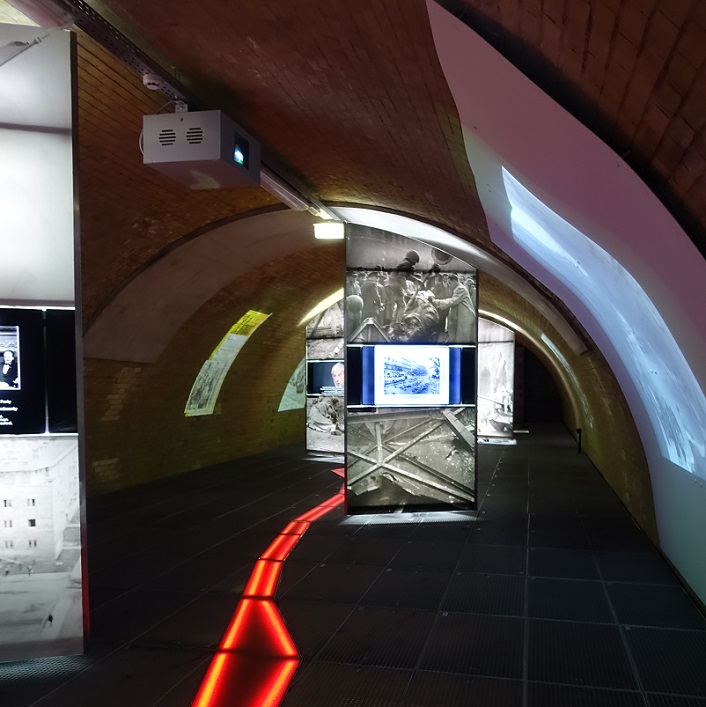
Amongst the exhibits was this collection of artefacts involving shells and (presumably) a victim’s shoe (or maybe a soldier’s?):
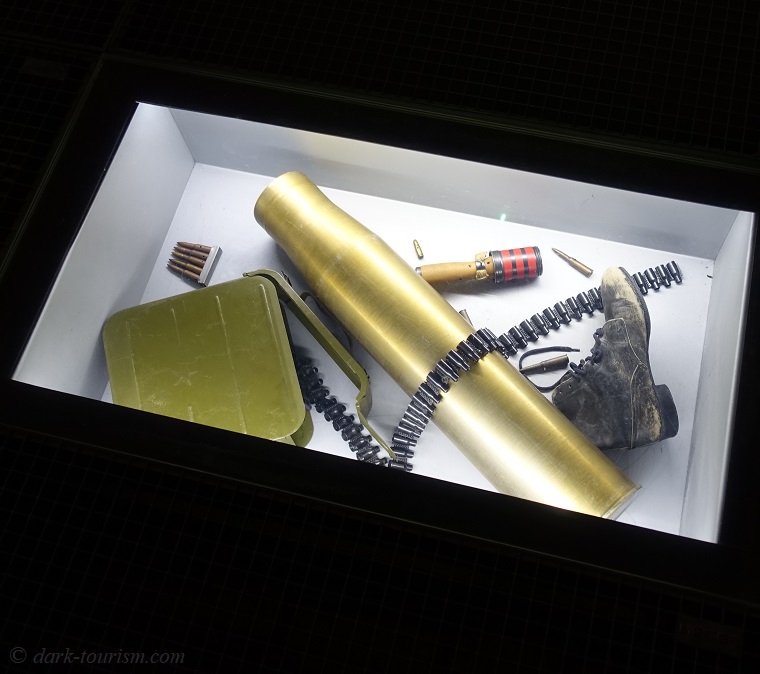
.
Not far from the parliament, right by the banks of the River Danube, can be found another very poignant memorial. It’s called “Shot into the Danube” and refers to the shooting of Jews and other victims by the right-wing Arrow Cross (the Hungarian equivalent of the German Nazis). It’s basically a cluster of several dozen empty metal shoe replicas:

In addition to this photo making use of the ‘bokeh’ effect (background blur, basically), here’s another photo of this shoe monument from a different angle showing the river and the Buda side of the city in the background (same as the featured photo at the top of this post):
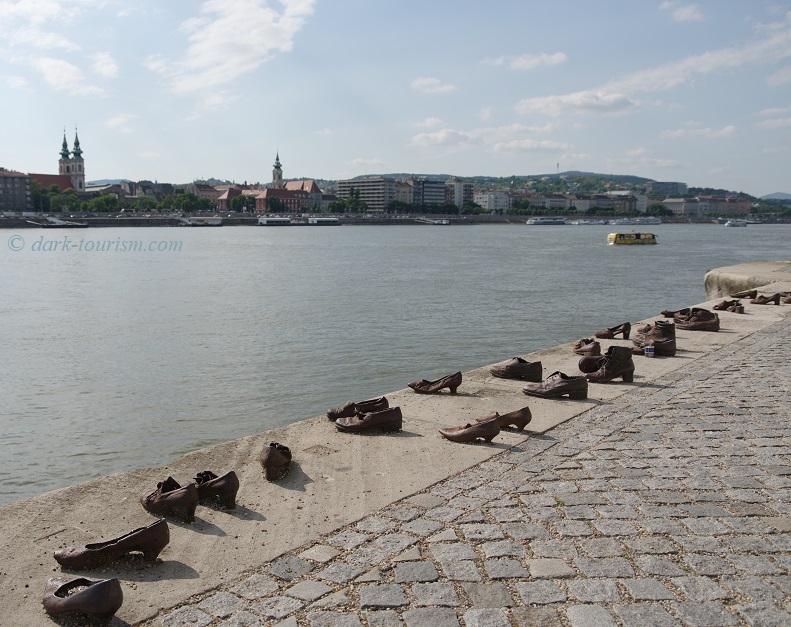
This is probably one of the most unusual and remarkable kinds of monuments and I had long wanted to finally see it with my own eyes. However, tourist behaviour at this place left much to be desired – with endless selfie-taking and positioning of little children amongst the shoes for snapshots. Clearly many people had no idea what was being commemorated here – and it didn’t help that the metal plaques in the pavement that do point this out (in three languages) are set back from the edge of the quay and will thus be overlooked by the uninitiated tourist. So such disrespectful behaviour can at least be explained.
.
Budapest is full of sculptures. I don’t think I’ve ever seen that many in any other city. They’re everywhere. Not all have a dark meaning, of course, in fact many are cheerful, funny even. But here’s one that brings us back to the tragic story of Imre Nagy:

This can be found in a small park to the north of the parliament and shows a life-sized Imre Nagy statue looking pensively out from a metal bridge. I found that quite atmospheric as well – and again, you have to know the background to get the full impact (a group of young kids that were clambering around on this bridge obviously didn’t … and couldn’t, really).
.
And finally, here’s a photo of the smallest kind of “monument” I came across on this trip to Budapest:

It was only about half the size of my hand and mounted on to the riverside stone wall on the western bank of the Danube. It’s probably also a reference to the 1956 Uprising, going by the appearance of the tank (it looks a bit like the Soviet T-54 tanks used in the crushing of the revolt – a real one is on display in the foyer of the House of Terror Museum).
But I think you can reinterpret this liberally as symbolic also for all military aggression and the wish that tank gun barrels could be made to droop like this to render them useless also in the most current large-scale war, the one that still keeps dominating the news …



